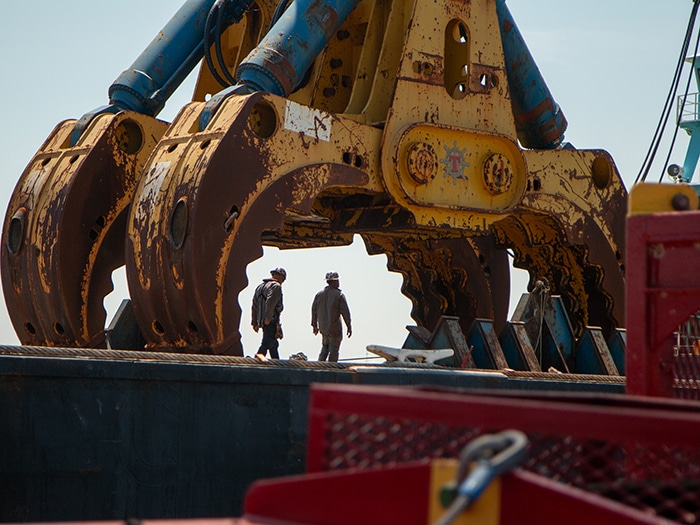
Salvors prepare the Chesapeake 1000 to use the HSWC500-1000 heavy duty hydraulic salvage grab to continue wreckage removal. [Key Bridge Response 2024 Unified Command photo by U.S. Army Corps of Engineers Public Affairs Specialist Dylan Burnell]
A giant claw is the latest massive piece of equipment to be added to the resources of the Unified Command responding to the collapse of the Francis Scott Key Bridge. The claw is actually a hydraulically operated salvage grab that is being mounted on Donjon Marine’s Chesapeake 1000 crane barge.
The 200-ton HSWC500-1000 heavy duty salvage grab has a 1,000 tonne capacity and will be used to help remove debris from the Patapsco River once the containership Dali is removed.
Operations to refloat and remove the ship are set to start soon. They will require vessel traffic through the new, temporary Fort McHenry Limited Access Channel to be suspended starting this week and that suspension could last roughly 10 days until it’s deemed safe for traffic to go through.
ONE MONTH LATER
The Unified Command noted Friday that one month had passed since the Dali struck the Francis Scott Key Bridge, which connects Hawkins Point and Dundalk, Maryland, causing its collapse into the lower Patapsco River and bringing all maritime traffic in and out of the Port of Baltimore to a standstill.
In the incident, eight road crew workers, who were on break from repairing potholes, were present on the bridge when it collapsed. While two workers were rescued, the remains pf four missing persons have been recovered, leaving two still unaccounted for. Efforts to locate the missing workers continue, with utmost care and concern for the well-being of the families affected by this tragedy.
As of Friday, 171 commercial vessels have transited the four alternate channels, including five of the vessels waiting to depart the Port of Baltimore since the bridge collapse
The Unified Command says that 137 containers of the estimated 180 necessary to access the portion of the bridge atop the Dali have been removed. Once the Dali is off the scene, the focus will shift to removing bridge wreckage from beneath the water, bringing that giant claw into play,
Presently, more than 350 uniformed and civilian workers from 53 federal, state, and local agencies across the U.S. are deployed to Baltimore for the ongoing recovery and salvage efforts. In addition, 553 contract specialists are actively involved in various roles related to dive, crane, and vessel operations. Over 1,000 individuals have contributed to the Key Bridge Response mission over the past month.
To address the estimated 50,000 tons of wreckage at the Francis Scott Key Bridge site, the Unified Command has assembled a substantial fleet of varied vessels and equipment (now including that giant claw). The vessels in the armada include 36 barges, 27 tugboats, 22 floating cranes, 10 excavators, one dredge, one skimmer, and three Coast Guard cutters. Progress in the salvage effort has been significant, with over 3,000 tons of wreckage and debris already removed from the site for disposal or recycling.
Ninety dive missions have been conducted by as many as seven dive teams, each consisting of four to five specialists. This tally does not include the numerous recovery-related dives undertaken within the initial 48 hours by over 60 divers from the Maryland State Police and other federal, state, and local agencies.
Survey vessels deployed by the Unified Command have executed more than 60 missions to gather sonar and laser imagery, essential for mapping the wreckage of the Dali and determining safe maritime navigation routes. This data, acquired day and night, is crucial for diver safety, enabling dive supervisors to guide underwater operations amidst the murky depths of the Patapsco River.
The National Oceanic and Atmospheric Administration’s Office of Coast Survey completed nine hydrographic survey assessments to help establish the temporary channels by identifying obstructions for salvage teams to remove. Following obstruction removal, the NOAA hydrographic survey team returned and verified the temporary alternate channels were clear and safe for vessel navigation.
Aerial efforts have also played a vital role, with more than 100 pilots and support specialists from over 35 agencies conducting 250 Unmanned Aircraft System missions and 60 manned helicopter and fixed-wing sorties. Serving as the literal eye-in-the-sky, the Air Operations branch has been instrumental from the early search and rescue phase to the ongoing salvage operations, providing essential oversight for Unified Command planners, operators, and leadership.





